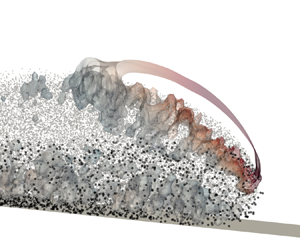Published online by Cambridge University Press: 18 September 2023

Multigrain/polydispersity has a significant impact on turbidity current (TC). Despite the fact that several researches have looked into this effect, the impact of the fluid–particle interactions is not fully understood. Motivated by this, we employ the Eulerian–Lagrangian computational fluid dynamics–discrete element method model to investigate the dynamics of the bidisperse lock-exchange TC. Results show that, because the coarse particles will settle faster and stop moving forward, the two phases of bidisperse transport and fine component transport can be distinguished in the evolution of the bidisperse TC. During the bidisperse transport stage, the upper interface of each component is primarily determined by their own settling and transport characteristics and does not strongly depend on the relative fine particle volume fraction  $\phi _F$. Fine particles are primarily responsible for the vortical structures near the upper interface of the TC head, and the increase of
$\phi _F$. Fine particles are primarily responsible for the vortical structures near the upper interface of the TC head, and the increase of  $\phi _F$ promotes their streamwise development. In comparison, fragmented vortical coherent structures are closely related to the presence of coarse particles, which can be seen in the lower layers. Bidisperse segregation alters the collision process between dispersed phases, which differs from monodisperse TC. The collisions and segregation-induced flow establish interconnections between the two dispersed phases. In the latter stage, the transport of fine particles is inhibited by both the lift force and the contact force produced by the collision with the deposited materials. As
$\phi _F$ promotes their streamwise development. In comparison, fragmented vortical coherent structures are closely related to the presence of coarse particles, which can be seen in the lower layers. Bidisperse segregation alters the collision process between dispersed phases, which differs from monodisperse TC. The collisions and segregation-induced flow establish interconnections between the two dispersed phases. In the latter stage, the transport of fine particles is inhibited by both the lift force and the contact force produced by the collision with the deposited materials. As  $\phi _F$ rises, the negative contact force weakens, and its change is essentially balanced by the rise in negative lift force.
$\phi _F$ rises, the negative contact force weakens, and its change is essentially balanced by the rise in negative lift force.
To send this article to your Kindle, first ensure no-reply@cambridge.org is added to your Approved Personal Document E-mail List under your Personal Document Settings on the Manage Your Content and Devices page of your Amazon account. Then enter the ‘name’ part of your Kindle email address below. Find out more about sending to your Kindle. Find out more about saving to your Kindle.
Note you can select to save to either the @free.kindle.com or @kindle.com variations. ‘@free.kindle.com’ emails are free but can only be saved to your device when it is connected to wi-fi. ‘@kindle.com’ emails can be delivered even when you are not connected to wi-fi, but note that service fees apply.
Find out more about the Kindle Personal Document Service.
To save this article to your Dropbox account, please select one or more formats and confirm that you agree to abide by our usage policies. If this is the first time you used this feature, you will be asked to authorise Cambridge Core to connect with your Dropbox account. Find out more about saving content to Dropbox.
To save this article to your Google Drive account, please select one or more formats and confirm that you agree to abide by our usage policies. If this is the first time you used this feature, you will be asked to authorise Cambridge Core to connect with your Google Drive account. Find out more about saving content to Google Drive.